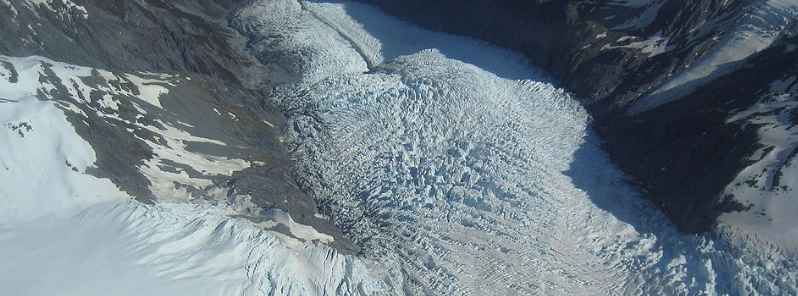Climate anomaly responsible for glacial growth in New Zealand

A new research carried out by scientists from the Victoria University of Wellington and the National Institute of Water and Atmospheric Research (NIWA) shows that regional climate variability caused an “unusual” period in which some of New Zealand’s glaciers grew bigger, while glaciers worldwide were shrinking.
At least 58 New Zealand glaciers advanced between 1983 and 2008, with Franz Josef Glacier (Kā Roimata o Hine Hukatere) advancing nearly continuously during this time.
“Glaciers advancing is very unusual – especially in this period when the vast majority of glaciers worldwide shrank in size as a result of our warming world,” says lead author Associate Professor Andrew Mackintosh from Victoria’s Antarctic Research Centre.
“This anomaly hadn’t been satisfactorily explained, so this physics-based study used computer models for the first time to look into it in detail.
“We found that lower temperature caused the glaciers to advance, rather than increased precipitation as previously thought. These periods of reduced temperature affected the entire New Zealand region, and they were significant enough for the glaciers to re-advance in spite of human-induced climate change.”
Associate Professor Mackintosh says the climate variability, which includes the cooler years, still reflects a climate that’s been modified by humans.
“It may seem unusual – this regional cooling during a period of overall global warming – but it’s still consistent with human-induced climate change. The temperature changes were a result of variability in the climate system that’s specific to New Zealand.
“New Zealand sits in a region where there’s significant variability in the oceans and the atmosphere – much more than many parts of the world. The climate variability that we identified was also responsible for changes in the Antarctic ice sheet and sea ice during this period."
Associate Professor Mackintosh says they found New Zealand glaciers that advanced had certain characteristics, including specific elevation and geometry.
“Franz Josef Glacier actually regained almost half of the total length it had lost in the twentieth century. However, Haupapa/Tasman Glacier, New Zealand’s largest glacier – which has about a third of all of New Zealand’s ice volume – continued to retreat. Because of that, New Zealand glaciers lost mass overall over this period.”
The study, funded by a core NIWA project ‘Climate Present and Past’, used computer modeling to understand the drivers of glaciers. The model was tested using more than a decade of field observations of glaciers in the Southern Alps, and a 30-year record of glacier photographs from the NIWA ‘End of Summer Snowline’ program.
Victoria University’s Dr. Brian Anderson and NIWA’s D.r Andrew Lorrey were also lead authors on the study, published recently in Nature Communications. Other authors include Professor James Renwick from Victoria’s School of Geography, Environment and Earth Sciences, Dr. Sam Dean, chief scientist for NIWA’s Climate Atmosphere and Hazards Centre, and visiting student Prisco Frei from ETH Zurich.
Dr. Lorrey says the long-term observations that NIWA maintain – which document New Zealand glacier snow line changes and high elevation climate variability – were critical to achieving the aims of the study.
Associate Professor Mackintosh says although glaciers advancing sounds promising, the future “doesn’t look good” for New Zealand’s glaciers.
“Franz Josef Glacier has already retreated more than 1.5 kilometers (0.93 miles) since the end of the advance in 2008.
“New Zealand’s glaciers are very sensitive to temperature change. If we get the two to four degrees of warming expected by the end of the century, our glaciers are going to mostly disappear. Some may experience small-scale advance over that time due to the regional climate variability, but overall they will retreat.”
Source: NIWA
Featured image: Franz Josef Glacier, New Zealand. Credit: Avenue

Should have substituted”anomaly” for reality…,the only anomaly I see are these GW scientist’s view of our world!